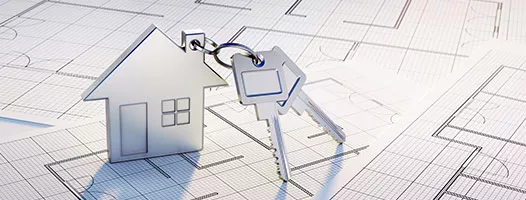Buying Land and Building a House on it - Land search and purchase

Buying land to build a house begins with finding the land you want to purchase. Once you have decided on the area where you want to live, the image of the house you want to build, and your approximate budget, check the requirements of the land to determine what kind of land you should look for. Here are some points to keep in mind when looking for land.
1. How much land do you need?
How much land do you need for the size of the house you want to build? In Japan, the limits on the size (area and volume) of buildings that can be built on land are determined by Building Coverage Ratio and Floor-Area Ratio of the land. Since the Building Coverage Ratio and Floor-Area Ratio are listed in the information on the land for sale, it is necessary to check the area and volume of the building that can be constructed based on the Building Coverage Ratio and Floor-Area Ratio against the number of square meters of the land.
Building Coverage Ratio
It is the ratio of the “Building area” to the Land area (site area).
Building Coverage Ratio (%)=Building area/Site area ×100

When viewed from above, the projected floor area of the building is called the building area. The upper limit of the building coverage ratio is regulated between 30% and 80%, depending on each Land Use Zone category.
In the "fire protection zones" where the structure of buildings is restricted, and in corner lots that meet certain requirements, there are relaxation measures for the designated building coverage ratio, which may effectively result in “no restrictions”.
Floor-Area Ratio
It is the ratio of the "Total floor area" to the Land area (site area).
Floor-Area Ratio(%)=Total floor area/Site area ×100

The total floor area is the sum of the floor areas of each floor of a building. The upper limit of the floor-area ratio is regulated between 50% and 500% in residential areas, depending on each Land Use Zone category. If the width of the frontal road is less than 12 meters, the value calculated by the road width × 0.4 (or 0.6) or the specified floor-area ratio, "whichever is smaller" will be applied.
For details, please refer to " Floor-Area Ratio (FAR) and Building Coverage Ratio (BCR) in Japan"
Even on the same 100 m2 of land, the size of the house that can be built will vary depending on the building coverage ratio and floor-area ratio.
| Case of a 2-story house on a plot of land with an area of 100 m2 | |
| ① In the case of a building coverage ratio of 60% and a floor-area ratio of 200% | ② In the case of a building coverage ratio of 40% and a floor-area ratio of 80% |
| Building coverage ratio of 60% → The building area is up to 60 m² | Building coverage ratio of 40% → The building area is up to 40㎡ |
| Floor-area ratio of 200%→ Total floor area is up to 200 m² | Floor-area ratio of 80%→ Total floor area is up to 80㎡ |
| 2-story house → Total floor area of 120㎡ 3-story house → Total floor area of 180㎡ |
2-story house → Total floor area of 80㎡ 3-story house → △ |
 |
 |
Let's calculate the required land area
Let's take a look at the case of a 2-story house of 120㎡ (3-4LDK) as a general house for a family of four. The required land area varies depending on the building coverage ratio as follows:
Building area of 120㎡÷2=60㎡
Land with Building coverage ratio of 40%: 60㎡÷40%=150㎡
Land with Building coverage ratio of 50%: 60㎡÷50%=120㎡
Land with Building coverage ratio of 60%: 60㎡÷60%=100㎡
Land with Building coverage ratio of 80%: 60㎡÷80%=75㎡
It depends on the floor-area ratio, but if you have a land with Building coverage ratio of 80%, you can build a house of 120㎡if you have an area of 75㎡. In addition to this, consider the required land area, including car parking space, bicycle parking space, garden area, and approach area.
However, there are other regulations that limit the size and height of buildings that can be constructed, in addition to the Building Coverage Ratio and Floor-Area Ratio, so be sure to ask your construction company to confirm the details.
2. How to find land
To search on the Internet
It is possible to search for land for sale on real estate portal websites, etc. If you cannot find land that meets your requirements by searching property information on land, it is also effective to search for detached houses. If the house is to be demolished and cleared, demolition and removal costs will be incurred and should be included in the budget.
“Land lot subject to construction of a house”, in which a house is built by a designated construction company after the land is purchased, may also be an option if you are not particular about a construction company.
To ask a real estate brokerage company
To find a property, it is common to consult with a real estate agent in the area where you want to live. If you provide specific conditions such as area, size, budget, etc., they will introduce properties that meet your requirements. We PLAZA HOMES welcome any questions or inquiries you may have and are here to provide the necessary support. Please feel free to contact us through this link.
To ask a construction company
If you already have decided on a house builder, construction company, or design firm you would like to request construction of your house, it will be smoother if you can consult with them from the land search stage. Some construction companies may be able to introduce you to land they own, or they can assist you in finding land through their affiliated real estate brokerage firms.
3. Points to check when choosing land
Once you have found a land that you like, consider specifically whether the area around the land has a good living environment and whether you can build a house that you envision on the land.
To check the living environment
Check the surrounding facilities for your daily needs, such as how many minutes it takes to get to the nearest station, the convenience of the supermarket or drugstore where you shop, the traffic volume and noise of nearby roads, and what kind of hospitals are nearby. If you have young children, check the safety of the school route and whether there is a park that can be used as a playground.
Ask the construction company to do a land survey.
Building a house on land is subject to restrictions under various laws such as Building Standards Act. Before purchasing the land, ask the construction company to survey the land to see if there are any problems to make sure that the house you envision can be built on the land you have chosen.
Restrictions on the type, volume, and height of buildings that can be built
As mentioned above, the type of building to be built is determined for each " Land Use Zone" defined by City Planning Act, and the scale of construction is determined by "Building coverage ratio" and "Floor-area ratio".
In addition, there are many height and slope lines around the site that must not be crossed, such as building height limit, road diagonal line restriction, north side slant line restriction, and shade regulation, and construction must be done within the range of these lines. Ask a construction company to create a building plan and diagnose whether a house of the desired volume can be built.
Type and width of the frontal road
A house cannot be built unless the land borders the frontal road by at least 2 meters. Note that if the width of the frontal road is less than 4 meters, a portion of the land will be unavailable up to the line set back 2 meters (setback) from the center line of the road. In addition, if the frontal road is a “private road”, it is necessary to confirm the right-of-way.
Boundary with the neighboring land
If you build a house, you will have a long-term relationship with your neighbors. To avoid trouble later, check where the boundary line between the site and the neighboring land will be, by being clearly stated in the presence of the owner of the neighboring land, or by issuance of Statement of Confirmation of Property Borderlines.
Infrastructure (water, sewerage, gas)
It is necessary to check whether the main pipes of water, sewage, and gas are buried in the road in front of the site. If not buried, significant installation costs may be required.
Ground strength and height difference
Reclaimed rice paddies and ponds are prone to land subsidence. Have a specialist survey the site conditions, including ground strength and height differences, and diagnose any problems that may arise in construction.
Disaster risk
Check the disaster risk of the site and the surrounding area. Each local government has prepared hazard maps for floods, tsunamis, storm surges, landslides, earthquakes, and other disasters. It is important to confirm whether the land is at risk of disasters.

- Apartments & Houses for Sale in Tokyo
- Listings of apartments, condominiums, and houses available for purchase in Tokyo.


















